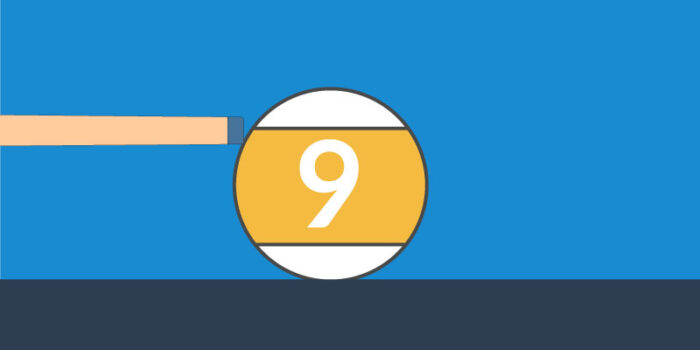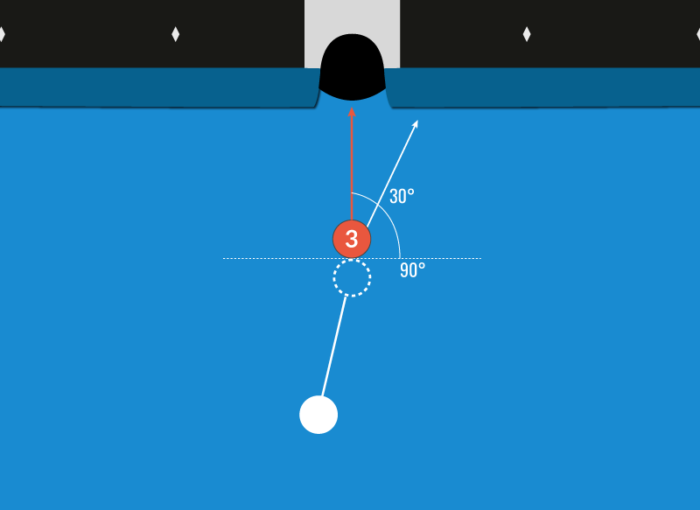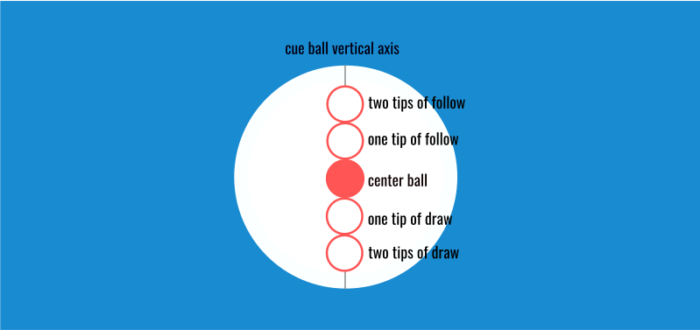What is Follow?
Follow is a type of spin that you can put on the cue ball. Another common name for follow in pool is top spin. The reason why the name follow is used is because when a cue ball with top spin hits an object ball, it “follows” the object ball in the same direction that it’s going in. The reason the cue ball continues to move forward after hitting the object ball is all due to the top spin that the cue ball has on it. The action of the cue ball spinning combined with the friction between the cue ball and the table causes the spin to grab and move it forward even after hitting a ball that’s stationary.
In the video above, the cue ball is spinning faster than it’s rolling while it’s moving forward which means it has a lot of follow on it. When it hits the object ball the cue ball keeps spinning which causes the it to go forwards after contact.
This doesn’t mean that the cue ball has to be hit with a lot of top spin in order to create a follow shot. In reality any ball that’s rolling forward has some degree of top spin on it. So even if you hit center ball, which stuns the cue ball and makes it slide without spin, eventually the cloth grips the ball and causes it to start rolling forward. Friction makes every shot want to have some natural follow on it, which is why it’s typically easier to apply follow than stun or draw. Only when the cue ball is sliding or has backspin at impact with the object ball does a shot not have follow.
Here the cue ball started out sliding, but after a few inches of travel it starts to gain natural roll which is the cue ball spinning forwards. That’s the reason the cue ball continued to move forward instead of stopping after it hits the object ball even though no top spin was applied to the cue ball with the cue itself. The spin that a cue ball picks up by just rolling across the table can be referred to as rolling english or running enlgish.
How to shoot a follow shot
Even though a rolling cue ball is enough to add follow, that usually takes distance for follow to build up depending on how much you need. If you want the cue ball to have top spin immediately after you hit the cue ball you need to hit high on the cue ball with a good follow through. The range for where you can hit the cue ball to apply follow is anywhere above the center of the cue ball to below ¾ of the cue ball.
The easiest way to measure the max height that you should hit the cue ball is to use a striped ball as a training tool. When you place a striped ball on the table with the stripe parallel with the surface of the table, the top of the stripe is the max height you can hit without miscuing.

Hitting anywhere within the range of above center ball to max top spin will result in varying amounts of top spin on the cue ball. More spin means the cue ball moves farther forwards after hitting the object ball. This can make the cue ball travel farther and it changes the trajectory of the cue ball on a lot of shots which helps play position.
It’s important to remember that adding top spin isn’t just about tip placement, it’s also about follow through. You need to accelerate through the cue ball in order to add a lot of spin. This should feel a little like you’re pushing the cue ball for a millisecond if you’re doing it correctly. A proper follow through and stroke is necessary for getting a lot of spin on the cue ball.
The effect of a follow shot
We already touched on it above, but the main effect of a follow shot is that it causes the cue ball to move forward. Shooting straight shots with follow are the easiest shots to predict because the cue ball will follow the object ball in an exact straight line.
However, most of the shots you shoot in pool aren’t straight in shots, so you’ll have to be able to predict where the cue ball is going on angled shots. This is where things get tricky, but it’s also the fun part about playing pool.
If read the lesson on stun shots you know that a cue ball hitting an object ball without spin will come off of that ball at a 90 degree angle from where it hit the object ball. We can use that as our baseline since we know that follow will cause the cue ball to go forward, which decreases the angle of the cue ball coming off the object ball after contact. So if you’re cutting the object ball at an angle and shooting a follow shot, the cue ball will come off of the object ball at less than a 90 degree angle.
30 Degree Rule
In fact, for follow shots where you’re hitting between ¼ and ¾ of the object ball you can use the 30 degree rule to figure out where the cue ball is going.

This is extremely useful for figuring out where the cue ball is going to go when using top spin. And since this rule applies for all cut shots between ¼ and ¾ in thickness there’s a really wide range where this is applicable.
Now when you’re at the table it’ll be tough to figure out what 30 degrees looks like until you get a feel for it. Fortunately your hand is a great tool for helping figure out what 30 degrees is, and all you need is your index finger and middle finger. So when you’re on a shot point your index finger where you want to hit the object ball to make it, and then stretch your middle finger out to make V. Where your middle finger is pointing is 30 degrees.
That rule will give you a very good idea of where the cue ball will go on a wide range of shots, but for thin cut shots or fairly straight shots, the angle that the cue ball goes off the object ball will be more or less than 30 degrees. For shots that are straighter, where you’re hitting more than ¾ of the object ball, the angle the cue ball comes off the object ball will be less than 30 degrees. For follow shots that are thin cuts hitting less than ¼ of the object ball, the angle of the cue ball off the object ball will start to get closer to 90 degrees after impact.
Cue tip placement
The easiest way to manipulate the cue ball path is to change cue tip placement. We already know that anything above center adds top spin, so changing where you hit above that range adds more and more follow the higher you go up on the cue ball. This is useful to know if you need to hit a ball hard, but only need a tiny bit of follow to get the right position. If you hit as high as you could, the cue ball will have a lot of top spin and it will go much farther forward than what you intended.
Changing tip placement on the cue ball is an easy, consistent way to change the amount of follow you put on the ball. If you’re keeping the speed you hit the cue ball the same and using the same stroke, it’s very simple to gauge how much spin your using. In fact many players measure how much spin they’re using by using tip distance. For instance if you place the cue tip at center ball and then move the bottom of your tip to the spot on the cue where the top of the tip was, that’s one tip distance. As long as you’re using the same cue every day, this is a consistent tip placement measurement system you can use when changing the amount of follow you’re using.

Varying speed to change when topspin grabs
The second factor to take into account when using follow is the speed of the shot. Speed can help add more top spin when you hit the ball harder, but it has another effect of making it take longer for the top spin to catch and change the cue balls trajectory.
In the example above, the cue ball is hit at two different speeds. And you can tell that on the slower shot, the top spin takes and changes the cue balls direction sooner than the faster shot. On the faster shot, the cue ball stays on it’s original path longer before the top spin grabs on the cloth and changes the balls direction. This can be useful when trying to play position for certain shots where a ball is in the way. You can essentially bend the cue ball around the obstructing ball if the balls are set up correctly.
Effect of speed of shot using follow
One final factor to keep in mind with follow is that it actually changes how far the cue ball will travel after it hits the object ball. This is important to know if the cue ball is out of position and you have a thinner hit on the object ball than you’d like. If you want to hold up the cue ball, then it’s wisest to not use follow and roll or drag the ball so it doesn’t pick up more speed.
